|
|
File
Land Reclamation Museum – San Donà di Piave
|
Viale Primavera 45 – 30027 San Donà di Piave (VE)
– Fax 0421 41334 |
  |
|
Summary
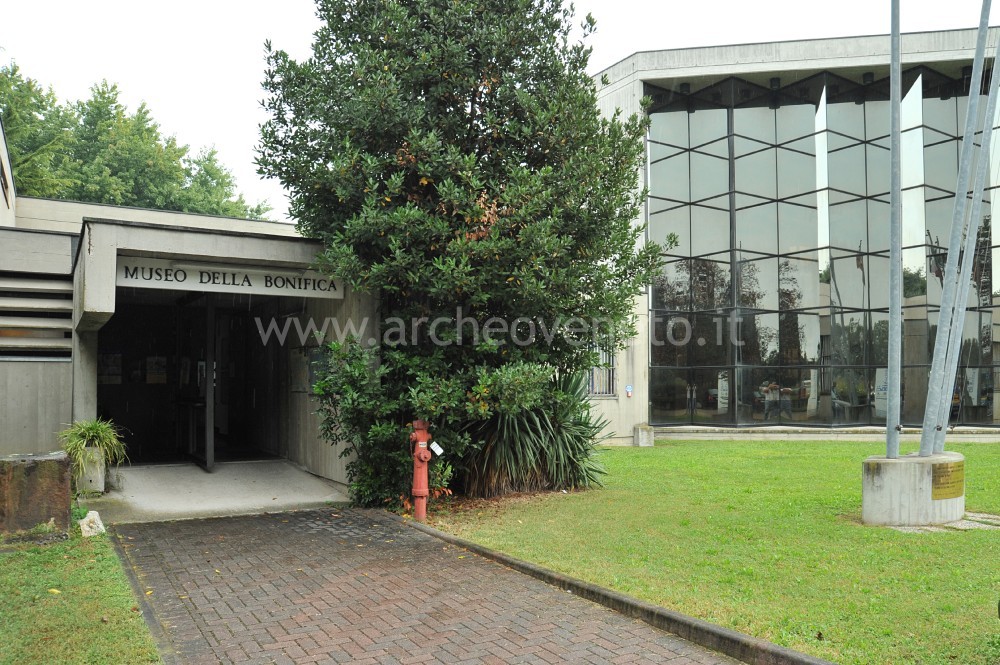
The Land Reclamation Museum of San Donà di Piave displays objects, pictures and scale models, organized according to chronological and typological criteria, which present the great reclamation works carried out in the area of San Donà from Antiquity till nowadays. The main feature of this museum is its close relation with the land (ecomuseum), as it is focused on the identity of the place, largely based on local participation and aims at enhancing the welfare and development of local communities. The museum is divided into various sections: Archaeology, Ethnography, War, Natural Sciences, as well as a section specifically devoted to the land reclamation.
Collection history
The building, in which the Land reclamation museum is located, was established in 1967 as convent of the Poor Clares; then in 1982 the Municipality purchased it with the purpose of arranging the rich demo-anthropological material regarding to the local rural communities and the events related to the great reclamation work carried out in the area surrounding San Donà. The museum opened in 1983, then in 1998 it was enlarged, including a new wing now that hosts the archaeological collection.
|

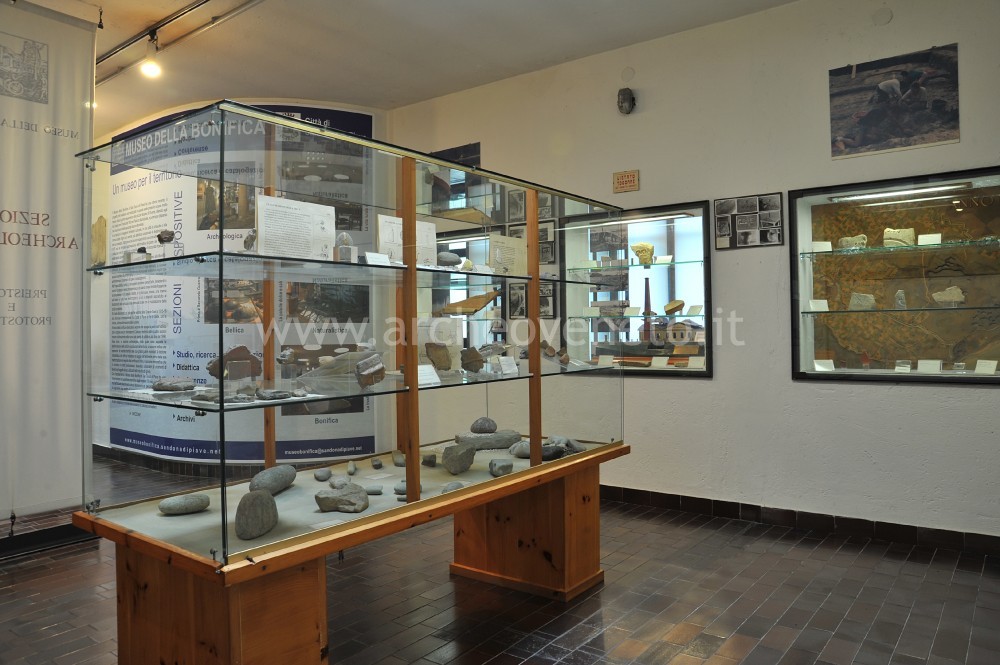 The first room is devoted to the prehistoric settlements of the area around San Donà. The first room is devoted to the prehistoric settlements of the area around San Donà.
The most ancient presence of human settlements dates back to Mesolithic (8000-4500 B.C.) and the numerous stone, bone and horn artefacts contained in the display case in the middle of the room refer to this era; they include a sleeker and a greenstone chopper (from Formighè), burins, scrapers, arrowheads, blades, two examples of worked deer antlers and a bone used as sharpened tool.
During the middle Bronze Age the area started to be systematically inhabited, with the following establishment of settlements on fluvial slopes or in the ancient riverbeds (in particular the one of the Piave river). Items dating back to this era can be seen in the central display case, which contains numerous examples of prehistoric pottery (fragments of decorated ollas, ring-shaped supports and fragments of bowls with handle) as well as querns used for grinding wheat or other grains from Formighè.
The display case on the right contains the archaeological finds discovered in Fossà, which prove the existence of a shrine used by the ancient Venetian people to worship the goddess Reitia. These finds consist of grey ceramic bowls, typically used for rituals (4th-2nd cent. B.C.) and animal bones (cattle, pigs, sheep). In the room there are also three display cases containing pottery dating back to the Roman age from the town of Cittanova (stamped tiles, brick stamps, fragments of Gaulish and African sigillata and a fragment of a lead token), from Grassaga, site of S. Teresina and property of the Giol family (stamped tiles and Roman brick stamp) and from San Donà di Piave, sites of Fiumicino and Cà Treviso (brick stamps).
|

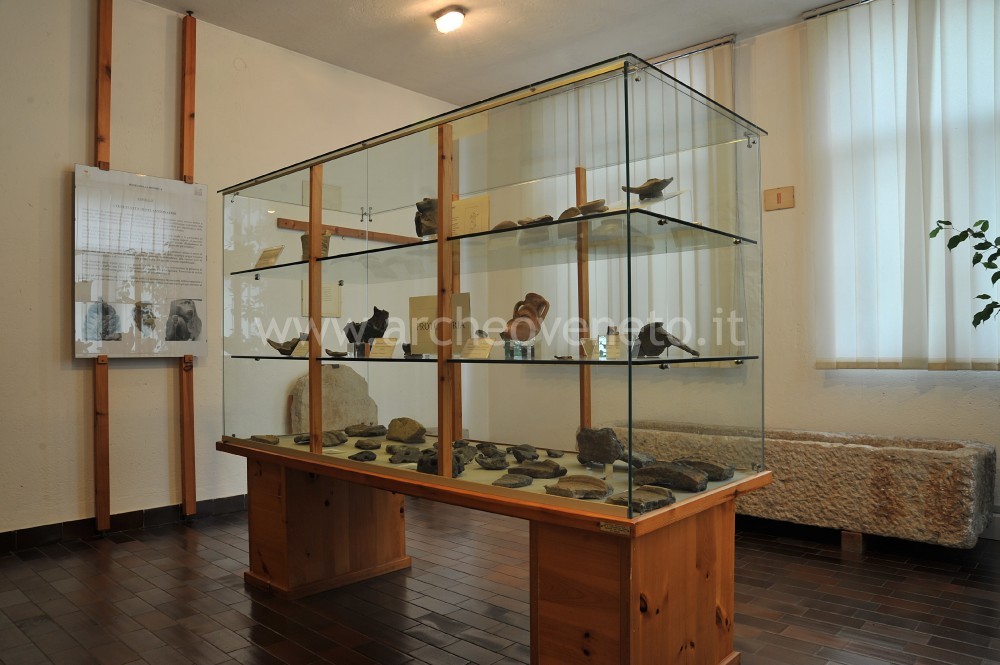 The second room displays the pre-roman finds discovered in the area around San Donà, which provide information on the settlements and the manufacturing centres, located in Veneto between the 4th-1st cent. B.C. and the Romanization period. The second room displays the pre-roman finds discovered in the area around San Donà, which provide information on the settlements and the manufacturing centres, located in Veneto between the 4th-1st cent. B.C. and the Romanization period.
The display case contains numerous fragments of grey pottery (cups, covering bowls, jugs and large ollas) with Venetic (4th-2nd cent. B.C.), Etruscan (4th cent. B.C.) and Latin (2nd-1st cent. B.C.) inscriptions, walls of large dolia decorated with relief strings (5th-3rd cent. B.C.) and pierced fragments of the cooking chamber of an oven (4th-2nd cent. B.C.) from the site Cà Treviso, in Fossà.
Next to them, there are also more ancient finds, which bear witness to the existence of contacts and trade relations with southern Italy, the East and the Celtic world; they include a rhyton with a satyr’s head (5th cent. B.C.), two fragments of Attic ceramic bowls (5th cent. B.C.), a mutilated statuette of the god Thot in black basalt (6th-4th cent. B.C.), a pierced bronze belt hook (5th cent. B.C.) and an amphora neck with an inscription in Venetic language, even though its content highlights Celtic influences (2nd cent. B.C.).
At the bottom of the room there is a large rectangular basin made of stone, which is very likely to have been originally designed for funerary practices (sarcophagus).
|

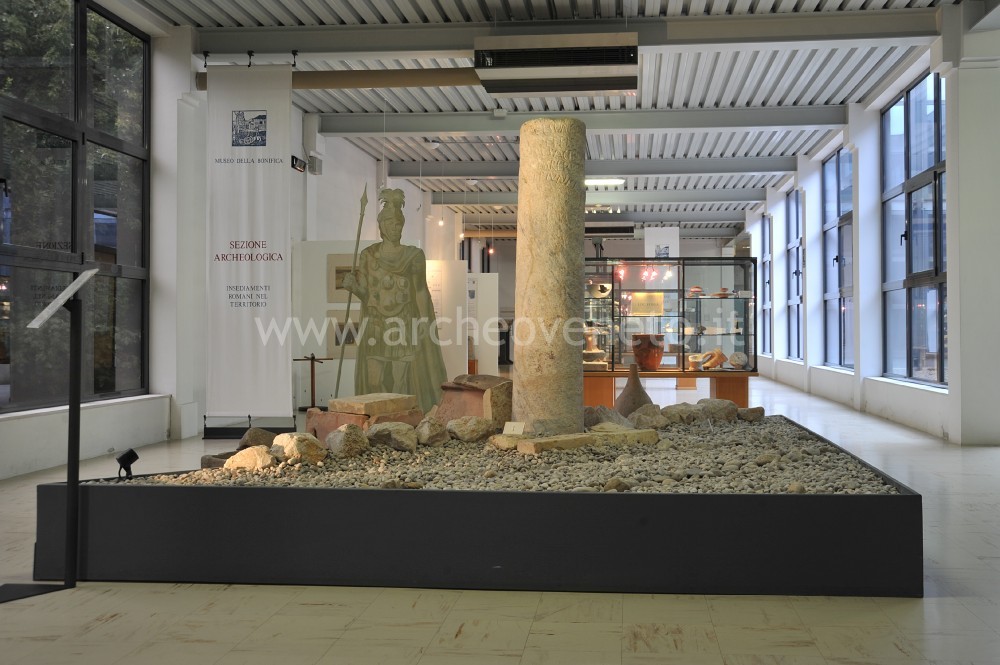 The last room, which is rather large, contains the finds providing information on the Roman penetration in the area of, which took place through the via Annia, the crucial road connecting Adria to Aquileia, and the important waterways of the area around San Donà; then the Roman presence consolidated through the important reclamation and centuriation works carried out in the area. The last room, which is rather large, contains the finds providing information on the Roman penetration in the area of, which took place through the via Annia, the crucial road connecting Adria to Aquileia, and the important waterways of the area around San Donà; then the Roman presence consolidated through the important reclamation and centuriation works carried out in the area.
At the centre of the room there are some reproductions showing the different kinds of burials that characterized the Roman age (burial in cut amphora, capuchin-type grave, in box of bricks or in limestone cist), as well as a reproduction of the layers making up the Roman roads. Particularly noteworthy is the milestone found on the side of the via Annia, in Fiorentina, with an inscription to Valentinian II, Theodosius I and Arcadius (388 A.D.).
The exhibition goes on with a display case containing the items discovered in Fossà; they include black varnish ceramic bowls (3rd-2nd cent. B.C.), coarse ceramic cooking ollas (1st cent. A.D.), thin-walled cups and ollas (1st-2nd cent. A.D.), numerous examples of north-italic (1st cent. A.D.) and African (4th cent. A.D.) sigillata, stamped tiles (1st-2nd cent. A.D.), two examples of “closed-channel” lamps and the neck of a wine amphora of the Dressel 6 type with top (1st-2nd cent. A.D.). Beside earthenware, there are also a tempered iron spearhead (3rd-4th cent. A.D.), fragments of bowls and unguentaria in blown glass (1st-2nd cent. A.D.), a bronze tintinnabulum (small bell), a bronze “bow” fibula, iron arrowheads (3rd-1st cent. B.C.) and a stone mortar.
The items contained in the following display case come from different sites within the area south of Oderzo occupied by the Romans and divided and distributed according the centuriation -Roman field system- (described by one of the panels); they include fragments of a protohistoric olla and of a votive tablet (4th-3rd cent. B.C.), the base of a bronze candlestick (1st cent. A.D.), a few lead weights for steelyard balance (1st-2nd cent. A.D.) and earthen weights for loom and fishing nets, a tempered iron ploughshare blaze (1st cent. A.D.), a part of quern, the neck of an oil amphora of the Dressel 6 type (1st-2nd cent. A.D.), a few stamped tiles (1st-2nd cent. A.D.), a stone architectural slab decorated with plant patterns (1st cent. A.D.), a glass necklace bead (1st-2nd cent. A.D.), some cups decorated with pod-shaped grooving and unguentaria in blown glass (1st-2nd cent. A.D.). Beside the panels explaining the Roman system of land division and distribution (centuriation), it is possible to see a groma, the tool used by the Romans to survey straight lines and right-angles for the boundaries of each field. Then there is also a display case containing a rich numismatic collection, mainly consisting of the coins discovered in Fossà and Cittanova, which cover a time span stretching from the Republican Age (2nd-1st cent. B.C.) to the 5th cent. A.D.
The third display case contains the finds discovered in the site Fiorentina-Fondo Pellizzaro, located along the fluvial slopes of the Piveran canal, ancient branch of the Piave river. Most of the displayed items are fictile objects (fragments of amphoras, of ceramic cooking ollas, of protohistoric ceramic cups, of covering bowls and loom weights), but there are also stone artefacts (lower part of a quern, stone weight for globular-shaped scales, fragments of a solar clock and stone mortar with pouring hole), metal objects (lead steelyard weights, two small bronze tintinnabula and a cross-shaped fibula with onion-shaped knobs) and other various materials (small fragmented clay spinning top, head of a hair pin, parts of multicoloured floors mosaics). At the centre of the display case there is also the reproduction of a loom with fictile truncated-conical weights.
The last part of the room focuses on the site of Eraclea Veneta-Cittanova, where human settlements made their appearance during the Bronze Age and lasted until the establishment of the Most Serene Republic of Venice. A whole display case is devoted to the Roman phase of this site; it contains numerous fragments of ceramic cooking ollas (1st-2nd cent. A.D.), necks of amphoras of the Dressel 6 type (1st-2nd cent. A.D.) and of Aegean origin (3rd-4th cent. A.D.), olpes, bowls and paterae in north-italic (1st-2nd) and African (4th cent. A.D.) sigillata, hollow fictile elements used as water pipes, tiles of floor mosaics, a moulded architectural cornice (1st-2nd cent. A.D.), a fictile brick with curved profile for a well rod (1st-2nd cent. A.D.), a bronze steelyard balance with graduated arm (1st-2nd cent. A.D.), lead weights for fishing nets and scales, limestone mortars and a fragment of funerary aedicule with inscription (1st cent. A.D.).
|
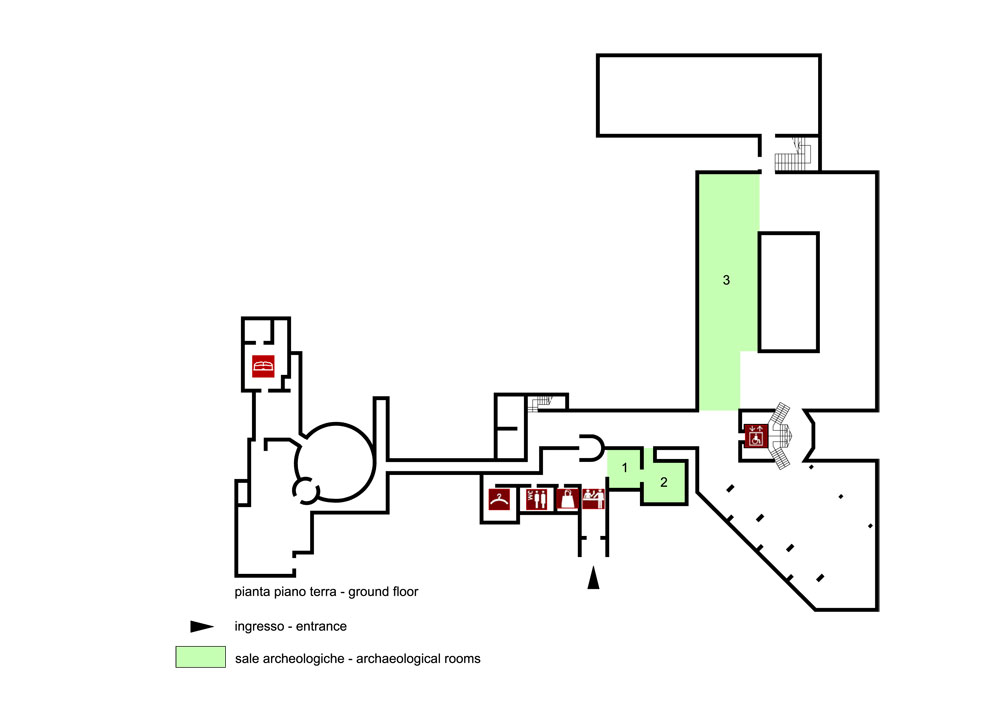
Admission: Negli orari di apertura
Ticket: Si
Price: Full fare: 3 €; reduced fare (16-18 years of age and seniors 65+): 2 €; school classes: 1 €.
 School access School access
 Disabled access Disabled access
Opening Days
| Tipology |
When |
Specs |
| Summer |
Tuesday |
09.00 – 12.30 (only schools) and 16.00 – 19.00 (all). |
| Summer |
Wednesday |
09.00 – 12.30 (only schools) and 16.00 – 19.00 (all). |
| Summer |
Thursday |
09.00 – 12.30 (only schools) and 16.00 – 19.00 (all). |
| Summer |
Friday |
09.00 – 12.30 (only schools) and 16.00 – 19.00 (all). |
| Summer |
Saturday |
09.00 – 12.30 (only schools) and 16.00 – 19.00 (all). |
| Summer |
Sunday |
09.00 – 12.00 |
| Winter |
Tuesday |
09.00 – 12.30 (only schools) and 15.00 – 18.00 (all). |
| Winter |
Wednesday |
09.00 – 12.30 (only schools) and 15.00 – 18.00 (all). |
| Winter |
Thursday |
09.00 – 12.30 (only schools) and 15.00 – 18.00 (all). |
| Winter |
Friday |
09.00 – 12.30 (only schools) and 15.00 – 18.00 (all). |
| Winter |
Saturday |
09.00 – 12.30 (only schools) and 15.00 – 18.00 (all). |
| Winter |
Sunday |
09.00 – 12.00 |
Summer openings: July and August
Recommended tour time (minutes): 40
 Toilet Toilet
 Parking Parking
 Bookshop Bookshop
 Rest points Rest points
 Guide a stampa Guide a stampa
Brochure
Italian and German
 Information boards Information boards
Italian and German
 Captions under exhibits Captions under exhibits
Italian
 PC learning points PC learning points
 Multilingual ads: Tedesco Multilingual ads: Tedesco
Panels and printed guide.
 Guided Tours Guided Tours
 Educational activities Educational activities
 Educational workshops Educational workshops
 Library and documentation centre Library and documentation centre
 Other activities Other activities
Conference Hall
| Casagrande D. 2003, Guida generale del Museo della Bonifica, Musile di Piave, pp. 17-31. |
|

